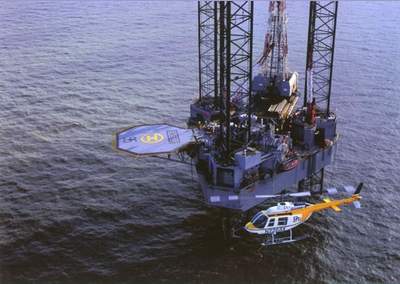I've been to my fair share of fly-ins. I've sat in enough
cockpits and seen enough "next big things" to last a lifetime. But
I couldn't wait to come to the Heli-Expo to see what the buzz is
all about. Did I say buzz? Maybe whir is more like it. Anyway, I
took a quick stroll through the exhibition hall a minute ago, and I
have to admit -- it's enough to make a fighter pilot envious.
This afternoon, our focus is on ADS-B. It's a transformational
technology that'll create a brand new NAS. It'll be the go-to
system for anyone and everyone who operates in remote areas at low
levels.
And, I want to say right off the bat, that the FAA is fully
committed to this program.
Yours is an industry on the go. You don't have time to wait.
Some of you have gone ahead and made your own investments for a
range of services. These include communications, weather and
satellite-based surveillance.

I'm proud of the fact that the FAA will now be able to provide
these services that many of you have been paying for -- services
that are available to the rest of the NAS. And I have to say, we're
charging ahead on a number of fronts to make it all a reality. The
key to making it all come together, of course, has been industry
partnerships.
The first wave of the ADS-B rollout, VHF air-to-ground
communications, is already under way. My FAA colleagues up here
will elaborate a little more on that in just a bit.
But I just want to point out a major milestone we're hitting
this week. The FAA is conducting a design review of ITT's ADS-B
system. Once that's done, it'll clear the way for the company to
begin sending equipment out to the platforms. This is the equipment
that'll be used for air traffic separation services.
What this all means is that by December of '09, the FAA will,
for the first time, be providing communications, weather and
surveillance to helicopter operators in the Gulf.
Picture that. Houston center will now have the ability to
separate ADS-B surveilled targets by next year.
Let me take a moment here to personally thank a few of the
operators for their valuable assistance. ERA Helicopters, Petroleum
Helicopters, Air Logistics, and Chevron. You flew our teams out to
the platforms for free. In addition, British Petroleum and Chevron,
among others, gave us valuable space for the equipment and power to
support our systems.

This is the kind of productive partnership we envisioned when we
signed the joint agreement back in '06. That was key. Quite
frankly, what it's going to accomplish is extraordinary.
We're essentially improving procedural NAS and creating
something extremely beneficial out of it. We're stretching the
airspace—extending it to the altitudes and the areas that you
operate in.
Others may be able to benefit from what we're doing too, like
EMS, or the air tour industry. With ADS-B, the possibilities are
all there.
At the top of that list, of course, is safety.
There's been a steady improvement in the overall accident rate
and fatal accident rate in the past few years. In '06, helicopters
flew over one million hours in the Gulf. And in that time, the rate
was 1.48 accidents for every 100,000 hours flown. Of the 1.48
accidents, 0.25 were fatal.
While this isn't on par with the commercial safety record, it's
important to keep in mind the kinds of operations in the
Gulf—brief trips from one elevated helipad to another, that
take place all day long.

With that kind of work, the margin for error is small because of
the operational hazards. But ADS-B can not only stretch the
boundaries of the NAS. It can stretch the net of safety too.
 All in all, we're
making great strides. And I think much of the credit goes to the
International Helicopter Safety Team. Their goal is to reduce the
worldwide military and civil helicopter accident rate by 80 percent
by 2016.
All in all, we're
making great strides. And I think much of the credit goes to the
International Helicopter Safety Team. Their goal is to reduce the
worldwide military and civil helicopter accident rate by 80 percent
by 2016.
With members like HAI, FAA, Transport Canada, and ICAO, I don't
see how the IHST can't hit that goal.
Now, since safety is the language that transcends all borders, I
have an announcement to make.
Last Thursday, I signed out a final rule for rotorcraft performance
and handling. It'll raise the safety bar another notch higher. And
more importantly, it reflects the evolution of rotorcraft
capabilities.
The rule harmonizes U.S. and European airworthiness standards
for rotorcraft. And, it represents the first changes to performance
and handling regulations in almost two decades. Many of you here
today provided technical expertise to the FAA, and I want to thank
you for your contributions.
Let me bring this to a close by stating what we all know. That
this is an exciting time in the rotor industry. And I'm proud of
the work that the FAA is doing to hit our ADS-B milestones. Like I
said a minute ago, we are committed to this program.
All of us up here from the FAA, we're looking forward to working
with Matt and Patrick Corr and the rest of the HAI team to see it
all the way through to completion.
Thanks very much for having me, and thanks for writing the next
chapter in rotorcraft history.
 SpaceX to Launch Inversion RAY Reentry Vehicle in Fall
SpaceX to Launch Inversion RAY Reentry Vehicle in Fall Aero-News: Quote of the Day (04.23.24)
Aero-News: Quote of the Day (04.23.24) Aero-News: Quote of the Day (04.20.24)
Aero-News: Quote of the Day (04.20.24) ANN's Daily Aero-Linx (04.20.24)
ANN's Daily Aero-Linx (04.20.24) Aero-News: Quote of the Day (04.21.24)
Aero-News: Quote of the Day (04.21.24)







